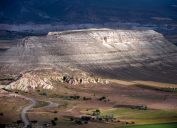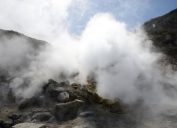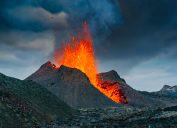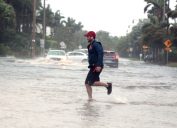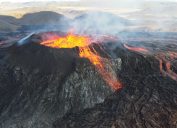Iceland Volcano Blows With "Spectacular" Eruption—What Happens Now
Fissures near the town of Grindavík have begun spewing lava following weeks of speculation.
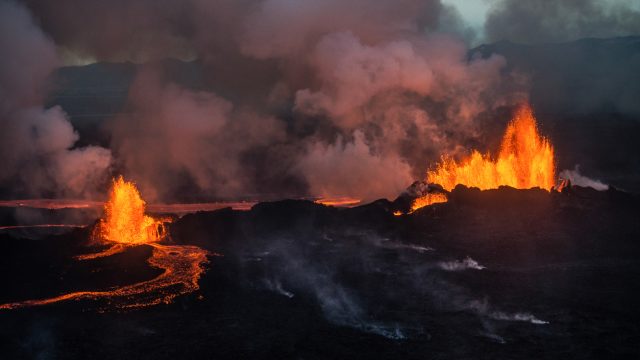
Iceland has become a top vacation destination in recent years thanks to its stunning natural beauty. The island nation's uniquely craggy landscape is famously thanks to high levels of volcanic activity that continue to shape and mold the terrain. But while most events there are handled without incident, some still catch international attention—including the eruption of the Eyjafjallajökull volcano in 2010 that led to significant disruptions in air travel due to billowing ash clouds, according to NASA. Now, another "spectacular" eruption is underway at a volcano in Iceland. Read on to see what happens now and if you'll be affected by the event.
RELATED: One of America's "Very High Threat" Volcanoes Keeps Quaking—Could It Erupt Any Day Now?
A volcanic eruption started on Iceland's Reykjanes peninsula after weeks of earthquakes and speculation.
Over the past several weeks, officials in Iceland have been anxiously monitoring developments on the Reykjanes Peninsula in the southwest corner of the country after thousands of earthquakes shook the area. Fears of an imminent eruption led to the evacuation of the town of Grindavík, temporary closure of the island's famous Blue Lagoon landmark, and undertaking of protective measures for the nearby Svartsengi geothermal power plant, The New York Times reports.
On Dec. 18, long fissures that had developed in the area finally began erupting as pillars of lava shot into the air. The event immediately lit up the night sky and could be seen from the capital city of Reykjavik, roughly 26 miles away, the BBC reports.
RELATED: Major Hurricanes Intensifying, New Data Shows—Is Your Region in Harm's Way?
Initial assessment of the eruption anticipated a worst-case scenario.
Scientists jumped to assess the severity of the eruption as soon as it began in an attempt to forecast how badly it could damage the surrounding area. Their earliest projections painted a grim picture, suggesting the intensity of the event could impact Grindavík and the nearby power plant, The Times reports.
"This is larger than previous eruptions on Reykjanes," Magnus Gudmundsson, a volcanologist, told the newspaper.
Even local residents who consider themselves accustomed to eruptions were alarmed by its force. "It was crazy to see it with my own eyes. We have had volcano explosions before, but this was the first time I got really scared," Aoalheiour Halldorsdottir, a resident of the town of Sandgeroi, roughly 12 miles from Grindavík, told BBC News. "We're used to volcanoes [erupting], but this was crazy."
RELATED: Italian Supervolcano Is Sparking Concern and Evacuation Plans.
However, scientists now say disruption from the event may not be as bad as they first thought.
But in the hours following the start of the powerful eruption, scientists were able to get more information and amend their assessments. Flyovers of the fissure led some scientists to walk back their initial calculations on potential damage to the surrounding areas—at least for now.
"The lava flow on the ground is still in a remote area, so at this point, it's not an immediate threat to the town Grindavík or the power plant Svartsengi. But there can still be a risk of lava flow damaging infrastructure," Freysteinn Sigmundsson, a geophysicist at the University of Iceland, told NBC News.
So far, the Icelandic Met Office says there have been no reports of any injuries related to the eruptions, the BBC reports. However, volcanic fumes could still pose a problem to nearby residents—especially if they suffer from respiratory issues, Sam Mitchell, PhD, a volcanologist at Bristol University in the U.K., told the BBC.
It's also unlikely the Iceland eruption will affect air travel as it did over a decade ago.
The Met Office says that despite "significant ground disruption" from the eruption that could last as long as 10 days, the initial force was already beginning to die down, per NBC News. But any travelers who are having flashbacks to the last major Icelandic eruption can also likely expect a different outcome this time around.
"It is completely valid for people to think back to 2010 and the impact caused across Europe, especially to air travel," Mitchell told the BBC. "The difference this time is that the volcano is not erupting explosively with water. So people should not worry about the airspace over Europe because the current eruption is nothing like what happened with Eyjafjallajökull."
And while local residents are now safe from the eruption, it's not exactly business as usual on the Reykjanes peninsula. The Blue Lagoon will remain closed through at least Dec. 27, and officials are warning any travelers hoping to get a once-in-a-lifetime snapshot to steer clear of the area as conditions continue to change, The Times reports.
"The fissure size is expanding fast," Hjordis Gudmundsdottir, a spokesperson for Iceland's Department of Civil Protection, said during an interview, adding that this was "no tourist volcano."
RELATED: For more up-to-date information, sign up for our daily newsletter.
